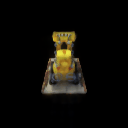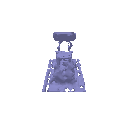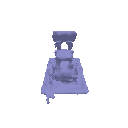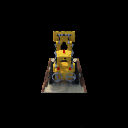Adnan Ahmad
Assignment 4
Late days used – 2
1. Sphere
Tracing

I implemented sphere tracing
as it was described in the lecture slides.
I instantiated a mask and ran
a while loop for fixed number of max_iter. The loop processed a batch of rays
where it computed ‘t’ – distance travalled along the ray till it hits the surface
(assuming it does).
This was done by adding the
sdf to t at every iteration until the distance to the surface was lower than a
fixed threshold. This made sense as sdf is the minimum distance the ray has to
travel to hit the surface so the ray couldn’t have gone inside the surface. For
rays that met the minimum threshold, a corresponding value was set in the mask,
indicating an intersecting ray.
All operations were done in a
vectorized manner.
2. Optimizing a Neural SDF


3. VolSDF


- How does high beta bias your learned SDF? What about low beta?
A high beta value leads to a
smoother function and a gradual transition for density values as the ray moves
in and out of the surface. This leads to smoother renderings. On the other hand a low beta value causes a more abrupt transition that
results in sharper looking outputs
- Would an SDF be easier to train with volume rendering and low beta or high beta? Why?
I believe a higher beta value will
be easier to train since it would learn a smoother function that changes
gradually which means it would probably result in faster convergence of the loss
function.
- Would you be more likely to learn an accurate surface with high beta or low beta? Why?
A lower beta would result in a surface that is sharper and more true to the actual GT 3D representation but it may be harder to learn. The lower beta will lead to step function like transition for the density values, which will cause abrupt gradients thereby making the learning involved.
Architecture choice – I chose a similar model design as the one I used in NeRF, except for a few changes. I had a common backbone of 6 linear layers with 256 nodes for the colour and sdf prediction but then 2 heads branched out and predicted them separately. I noticed that having a common backbone was essential as not sharing learning between colour and sdf led to weird artifacts where random colour was being assigned to empty space outside the 3d model. Therefore the learning for geometry and colour complimented each other.
I let all other hyperparameters stay the same as the config file and it seemed to work well.
4.2 Fewer
Training Views
|
|
VolSDF |
NERF |
|
Views
= 20 |
|
|
|
Views
= 100 |
|
|
|
|
|
|
|
|
|
|
|
|
|
|
It can be seen when the views are limited to 20 and the object is not perhaps sampled sufficiently from all directions, that it leads to better reconstruction in the case of VoLSDF than NeRF. In the case of Nerf, there is more blurring visible at the backside of the lego block, this may be because the model has not seen enough of that view and hence may be hallucinating. In a similar situation, VoLSDF performs a lot better with a cleaner and sharper rendering that is more true to the GT representation
4.3
Alternate SDF to Density function
I implemented the naďve function below from the paper and used an S value of 50
![]()
S = 50





